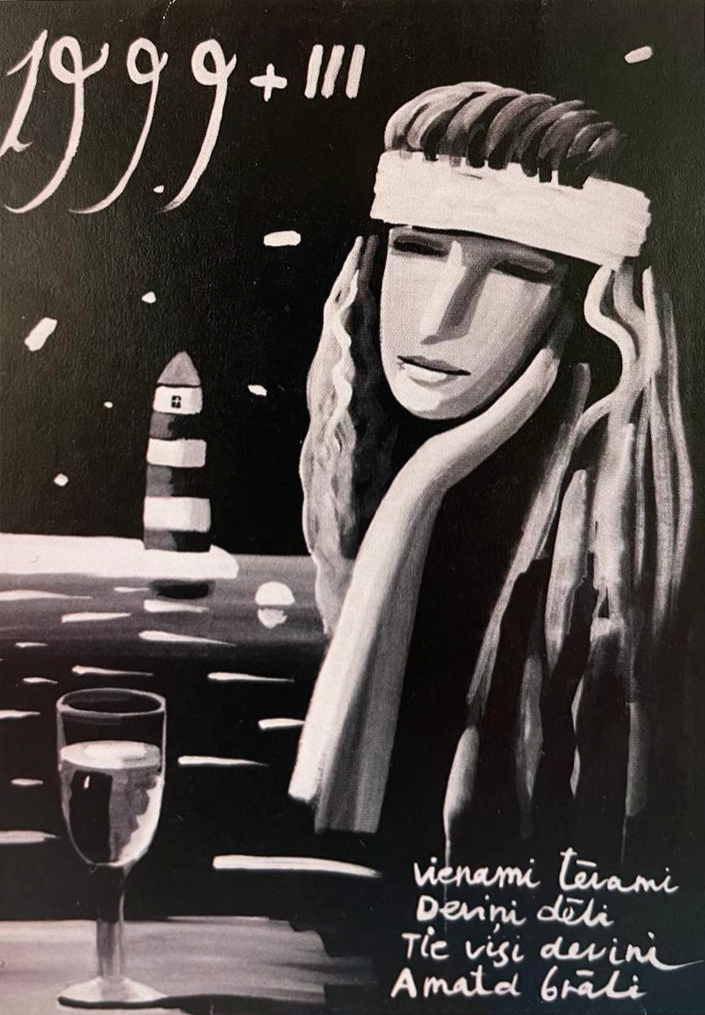
Ilona Gansovskaya’s mindful work emerges from conversation between environmentalism, Latvian & Estonian contemporary art, local folk literature and Eastern European arthouse cinematography. Ilona’s aesthetic attitude demonstrates an influence of early novels of the modern fantasy genre.
Ilona Gansovskaya was born in 1955, in Russia, into a family of writers – her father, Sever Gansovsky, was a Soviet fantasy and science fiction author and her uncle, Valentin Pikul, – a historical novelist. Gansovskaya has graduated from Moscow State Academic Art Institute named after V.I. Surikov, with a degree in scenography. Her main occupations were stage design and fine art, although she also worked in illustration and animation industries and as a graphic designer.
Ilona’s wondrous and intellectual work, invigorating as a breath of crisp air, has touched many hearts across the planet and her solo exhibitions were held in Latvia, Poland, USA, Japan and other locations. She was a member of Russian and Latvian Unions of Artists.
Ilona’s artworks appear naturalistic and in spite of that – otherworldly, full of ethereal radiance, where every minor detail, no matter how small, is recognisable, and yet proves to be a phantom.
According to Ilona, the painting process involved patiently and attentively observing her subjects until she could perceive and capture a mysterious hidden presence – something soul-stirring, primordial, difficult to grasp and define, alive, “piercing, dramatic and tragic in a way”. In her oeuvre, this inexplainable powerful presence is camouflaged by outer coldness and stillness, but still shines through – as if a flickering fire is covered and masked by an Arctic ice cap, lending the artworks special magnetism, intensity and peculiar evocative light.
The artist aspired to create fantastical uncluttered space by the means of natural occurrences such as tints and glow. She distilled her subjects, producing succinct, laconic and ingenious work, but still managing to preserve whole range of emotions and feelings.
Gansovskaya designed the sets for no less than thirty productions, including “The Snow Queen” at Vladivostok’s Academic Drama Theatre of Primorye Region named after Maxim Gorky, “Mozart and Salieri” and Pyotr Tchaikovsky’s “Iolanta” at Novosibirsk State Academic Theatre of Opera and Ballet. She collaborated with Moscow’s Vakhtangov Theatre, as well as with theatres in Czech Republic and Tatarstan Republic such as V.M. Kachalov Kazan Academic Russian Drama Theatre and M. Dzhalil Tatar State Academic Theatre of Opera and Ballet.
Ilona’s unconventional paintings perpetuate a reverent attitude towards nature and respect for life in all its manifestations. They assert an inseparable connection between all beings as equals and question anthropocentric attitudes.
Gansovskaya was a proponent of veganism and has executed a series of conceptual art projects associated with protecting animal rights, for instance “The Animal Project” that achieved substantial media coverage. The artist was honoured with a prize for ‘an exceptional contribution to nature conservation movement’ that was awarded to her in Kyiv at the Second International Humanitarian Film Festival.
Interestingly enough, Gansovskaya was compassionate and gentle towards the world and all other beings, but when it comes to herself – she was adventurous, selfless and somewhat reckless. Ilona transitioned to a plant-based diet early in her life purely because of ethical concerns, and she admitted herself that she always enjoyed doing things that are deliberately risky and unhealthy such as car racing and drinking wine in ‘romantic, poetic situations – for example, outside amid a winter storm, while standing in knee deep snow’.
By the press and the critics, Ilona was often described as ‘a Nordic water nymph with limpid eyes and flowing blonde hair’, ‘Nature personified’ and ‘daughter of the northern seas’.
Ilona’s images are paradoxical in a sense. Through focusing on nature, the paintings exude feminine vulnerability and, on the other hand, they radiate a manly courage due to their fundamentality, integrity and frankness.
For Ilona, time revealed itself in the process of painting; she asserted that ‘time is not a measure of ageing, but is an instrument required to compose beauty.’ Ilona handled her subjects carefully as if she was worried about causing any kind of disruption to the natural magic of things.
Short texts often accompanied Ilona’s creations, many were derived from Latvian, Polish and Spanish folk literature. Gansovskaya felt at home in Poland and was very fond of Latvian and Estonian cultures and contemporary artists. In 2005, Ilona has moved to her favourite city – Riga, where she lived and worked until the end of her days. In 2008, Ilona Gansovskaya has tragically died immediately after a car accident that she got into on Volokolamsk highway. It happened during the winter solstice – at the longest night of the year, between 22nd and 23rd of December.
*required fields
We will process the personal data you have supplied in accordance with our privacy policy (available on request). You can unsubscribe or change your preferences at any time by clicking the link in our emails.